The global single-axis drives market is forecasted to grow from USD 273.5 million in 2025 to approximately USD 480.7 million by 2035, recording an absolute increase of USD 207.2 million over the forecast period. This translates into a total growth of 75.8%, with the market forecast to expand at a CAGR of 5.8% between 2025 and 2035. The market size is expected to grow by nearly 1.76 times during the same period, supported by the rising adoption of automation technologies and increasing demand for precision motion control solutions across various industrial applications.
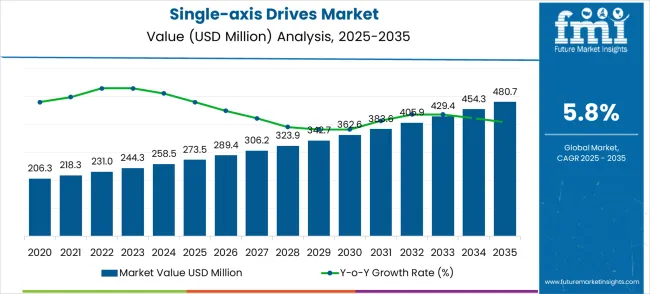
Between 2025 and 2030, the market is projected to expand from USD 273.5 million to USD 362.6 million, resulting in a value increase of USD 89.1 million, which represents 43.0% of the total forecast growth for the decade. This phase of growth will be shaped by rising penetration of automation technologies in manufacturing applications, increasing demand for precision positioning systems, and growing adoption of advanced motion control solutions. Drive manufacturers are expanding their technological capabilities to address the growing complexity of modern automation requirements across multiple industrial sectors.
From 2030 to 2035, the market is forecast to grow from USD 362.6 million to USD 480.7 million, adding another USD 118.1 million, which constitutes 57.0% of the overall ten-year expansion. This period is expected to be characterized by the expansion of advanced servo control technologies, the development of enhanced precision positioning capabilities, and the advancement of intelligent motion control systems. The growing adoption of Industry 4.0 applications and integrated automation solutions will drive demand for more sophisticated drive technologies and specialized motion control capabilities.
Between 2020 and 2025, the market experienced steady growth, driven by increasing automation initiatives and growing awareness of the benefits of precision motion control. The market developed as manufacturing companies and equipment producers recognized the need for accurate, reliable positioning solutions to enhance production efficiency. Semiconductor manufacturers and medical device companies have begun emphasizing the advantages of advanced drive technology, including superior positioning accuracy and operational reliability.
| Single-axis Drives Market | Value |
|---|---|
| Market Value (2025) | USD 273.5 million |
| Market Forecast Value (2035) | USD 480.7 million |
| Market Forecast CAGR | 5.8% |
Market expansion is being supported by the rapid increase in automation initiatives worldwide and the corresponding need for precision motion control systems that provide superior positioning performance and operational reliability. Modern manufacturing processes rely on accurate positioning and motion control to ensure optimal production outcomes including quality consistency, throughput optimization, and process efficiency applications. Even minor positioning inaccuracies can require comprehensive process adjustments to maintain optimal manufacturing standards and operational effectiveness.
The growing complexity of automation requirements and increasing demand for high-precision positioning solutions are driving demand for single-axis drive systems from certified manufacturers with appropriate motion control capabilities and technical expertise. Manufacturing companies are increasingly requiring documented positioning accuracy and drive reliability to maintain product quality and operational effectiveness. Industry specifications and performance standards are establishing standardized motion control procedures that require specialized drive technologies and calibrated positioning systems.
The single-axis drives market is entering a growth phase driven by increasing automation adoption, rising demand for precision manufacturing, and technological advancement. As manufacturers across both developed and emerging markets seek drives that deliver superior positioning accuracy, operational reliability, and comprehensive motion control capabilities, single-axis systems are evolving from basic positioning devices to sophisticated motion solutions integrated with servo control, intelligent feedback, and advanced automation technologies.
Rising industrialization and manufacturing modernization in Asia-Pacific, Latin America, and Middle East & Africa amplify demand, while manufacturers are advancing innovations in positioning accuracy, response time optimization, and integration capabilities improvements. Pathways like smart drive integration, multi-application compatibility, and IoT-enabled systems promise strong margin uplift, especially in mature markets. Geographic expansion and localization will capture volume growth, particularly where automation infrastructure is developing or modernization programs are underway. Industry standards around precision requirements, safety specifications, and automation integration provide structural market support.
The market is segmented by drive type, application, and region. By drive type, the market is divided into Ball Screw Driven, Toothed Belt Driven, and others. Based on application, the market is categorized into semiconductors, chemicals, medical, logistics, and others. Regionally, the market is divided into North America, Europe, East Asia, South Asia & Pacific, Latin America, and Middle East & Africa.
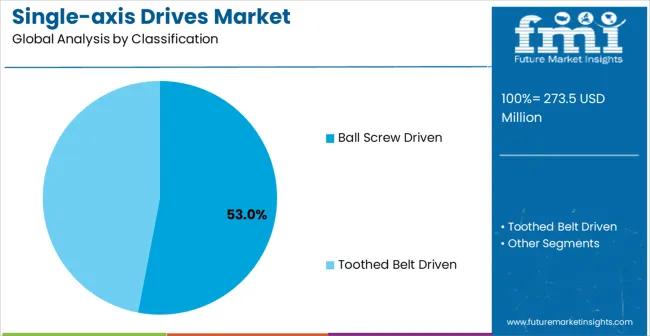
In 2025, the ball screw driven segment is projected to capture around 53% of the total market share, making it the leading drive technology category. This dominance is largely driven by the widespread adoption of proven ball screw technologies that deliver reliable positioning with excellent accuracy across various industrial applications. The Ball Screw Driven system is particularly favored for its ability to provide consistent performance in both high-precision and heavy-load applications, ensuring operational flexibility for manufacturing companies. Semiconductor equipment manufacturers, medical device producers, automation integrators, and precision machinery suppliers increasingly prefer this drive type, as it meets demanding positioning requirements without imposing excessive maintenance needs or complex calibration procedures. The availability of well-established ball screw technologies, along with comprehensive technical support and application expertise from leading manufacturers, further reinforces the segment's market position. Additionally, this drive category benefits from consistent demand across regions, as it is considered a reliable standard solution for companies with varying precision requirements.
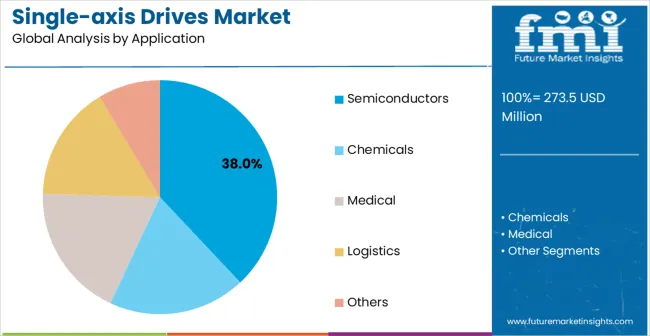
The semiconductors segment is expected to represent 38% of single-axis drive demand in 2025, highlighting its position as the most significant application sector. This dominance stems from the unique operational needs of semiconductor manufacturing applications, where ultra-precise positioning and reliable motion control are critical to effective chip production and wafer processing. Semiconductor applications often feature extremely demanding positioning requirements that necessitate consistent motion control throughout extended production runs, requiring dependable and highly accurate single-axis drives. Single-axis drives are particularly well-suited to these applications due to their ability to deliver precise positioning quickly and repeatedly, even during intensive manufacturing operations and varying process conditions. As semiconductor companies expand globally and emphasize improved production yields, the demand for advanced motion control solutions continues to rise. The segment also benefits from heightened focus on manufacturing precision initiatives, where semiconductor equipment manufacturers are increasingly prioritizing accurate positioning and consistent motion quality as key components of comprehensive process control programs. With technology companies investing in advanced manufacturing capabilities and production optimization, single-axis drives provide an essential solution to maintain high-performance motion control capabilities.
The market is advancing steadily due to increasing automation initiatives and growing recognition of precision motion control advantages over conventional positioning methods. However, the market faces challenges including higher initial system costs compared to basic positioning devices, need for specialized programming and integration expertise, and varying performance requirements across different applications. Technology advancement efforts and motion control optimization programs continue to influence drive development and market adoption patterns.
The growing development of advanced servo control systems is enabling higher positioning accuracy with improved response characteristics and enhanced motion smoothness. Enhanced servo technologies and optimized control algorithms provide superior motion performance while maintaining compliance with industrial requirements. These technologies are particularly valuable for manufacturers who require reliable drive performance that can support demanding applications with consistent positioning accuracy and operational reliability.
Modern single-axis drive manufacturers are incorporating advanced sensing features and diagnostic improvements that enhance system reliability and drive effectiveness. Integration of advanced feedback systems and optimized motion monitoring enables superior positioning results and comprehensive motion control capabilities. Advanced drive features support operation in diverse manufacturing environments while meeting various precision requirements and operational specifications, including semiconductor processing, medical equipment, and automated assembly applications.
The continuous development of enhanced modular design approaches and standardized interfaces is improving installation flexibility while maintaining consistent motion performance throughout diverse applications. Advanced modular features and intelligent configuration systems provide comprehensive motion capabilities that support extensive automation projects without compatibility issues. These design innovations are particularly valuable for applications requiring flexible motion solutions where drive adaptability and consistent performance are essential for effective system integration and operational efficiency.
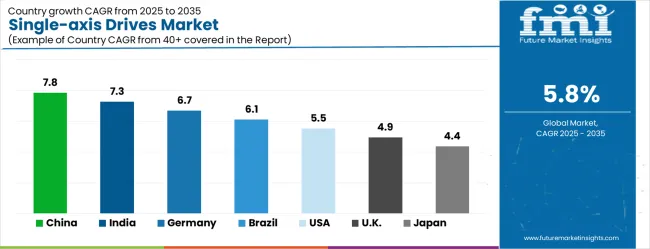
| Country | CAGR (2025-2035) |
|---|---|
| China | 7.8% |
| India | 7.3% |
| Germany | 6.7% |
| Brazil | 6.1% |
| United States | 5.5% |
| United Kingdom | 4.9% |
| Japan | 4.4% |
The market is growing steadily, with China leading at a 7.8% CAGR through 2035, driven by strong manufacturing expansion and increasing adoption of automation technologies. India follows at 7.3%, supported by rising industrial infrastructure development and growing awareness of precision motion control solutions. Germany grows steadily at 6.7%, integrating advanced drive technology into its established manufacturing infrastructure. Brazil records 6.1%, emphasizing industrial modernization and automation technology initiatives. The United States shows solid growth at 5.5%, focusing on technology innovation and manufacturing efficiency. The United Kingdom demonstrates steady progress at 4.9%, maintaining established automation applications. Japan records 4.4% growth, concentrating on precision enhancement and technological optimization.
The report covers an in-depth analysis of 40+ countries; top-performing countries are highlighted below.
China is projected to exhibit the highest growth rate with a CAGR of 7.8% through 2035, driven by rapid expansion of manufacturing infrastructure and increasing demand for automation technologies. The country's growing focus on manufacturing modernization and expanding semiconductor production are creating significant demand for precision motion control solutions. Major drive manufacturers are establishing comprehensive supply chains to support the increasing requirements of equipment manufacturers and automation integrators across semiconductor and electronics applications. Government industrial upgrade initiatives are supporting establishment of modern automation capabilities and advanced motion control systems, driving demand for sophisticated drive technology throughout major manufacturing centers and technology hubs. Manufacturing transformation programs are facilitating adoption of precision automation technology that enhances production effectiveness and motion control standards across manufacturing networks. The Chinese government's commitment to advancing manufacturing capabilities and improving industrial competitiveness is accelerating investments in advanced motion control solutions. National technology development projects and smart manufacturing initiatives are incorporating intelligent motion systems that require sophisticated positioning capabilities. Electronics manufacturing expansion and semiconductor production programs are creating additional demand for professional-grade drives that meet international precision standards and reliability requirements.
India is expanding at a CAGR of 7.3%, supported by increasing industrial infrastructure development and growing awareness of automation technology benefits. The country's expanding manufacturing sector and rising precision control standards are driving demand for professional-grade motion control solutions. Equipment manufacturers and automation companies are gradually implementing advanced drive technology to maintain competitive standards and operational effectiveness. Manufacturing sector growth and infrastructure development are creating opportunities for drive suppliers that can support diverse application requirements and performance specifications. Professional training and development programs are building technical expertise among engineering personnel, enabling effective utilization of motion control technology that meets manufacturing standards and positioning accuracy requirements across metropolitan regions. India's rapid industrialization and increasing electronics manufacturing are intensifying the need for effective motion control capabilities and automated positioning systems. National manufacturing initiatives and industrial infrastructure projects are establishing comprehensive automation systems that require advanced drive solutions. Government initiatives focusing on manufacturing improvement and technology advancement are driving procurement of modern motion control technology for manufacturing companies. The growing emphasis on professional engineering training and technology standardization is supporting adoption of internationally certified motion control systems.
Germany is projected to grow at a CAGR of 6.7%, supported by the country's emphasis on manufacturing quality standards and advanced motion control technology adoption. German manufacturers are implementing sophisticated drive systems that meet stringent precision requirements and operational specifications. The market is characterized by focus on positioning accuracy, motion reliability, and compliance with comprehensive quality standards. Manufacturing industry investments are prioritizing advanced motion control technology that demonstrates superior positioning performance and reliability while meeting German quality and operational standards. Professional certification programs are ensuring comprehensive technical expertise among engineering professionals, enabling specialized motion control capabilities that support diverse manufacturing applications and operational requirements across industrial networks. Germany's commitment to maintaining the highest manufacturing standards in Europe drives continuous investment in cutting-edge motion control technology. The country's comprehensive industrial infrastructure requires sophisticated drive solutions that meet strict precision and reliability standards. Integration with Industry 4.0 systems and digital manufacturing networks is creating demand for advanced motion control technology with enhanced connectivity capabilities. Manufacturing companies are modernizing their positioning capabilities through procurement of state-of-the-art drive systems that support both traditional manufacturing and automated production operations.
Brazil is growing at a CAGR of 6.1%, driven by increasing industrial development and growing recognition of automation technology advantages. The country's expanding manufacturing infrastructure is gradually integrating professional-grade motion control technology to enhance operational capabilities and equipment effectiveness. Manufacturing companies and automation integrators are investing in drive technology to address evolving precision requirements and competitive standards. Industrial modernization is facilitating adoption of advanced motion control technologies that support comprehensive positioning capabilities across manufacturing and industrial regions. Professional development programs are enhancing technical capabilities among engineering personnel, enabling effective motion control technology utilization that meets evolving manufacturing standards and operational requirements throughout industrial networks. Brazil's growing industrial sector and expanding automotive manufacturing infrastructure are driving demand for sophisticated motion control solutions. Federal and state government initiatives focused on advancing manufacturing capabilities and improving industrial competitiveness are supporting procurement of modern motion control technology. Manufacturing expansion and increasing automation applications in major metropolitan areas require enhanced positioning capabilities that can support effective production operations. The expansion of professional industrial services and specialized automation centers is creating sustained demand for reliable, accurate single-axis drive systems.
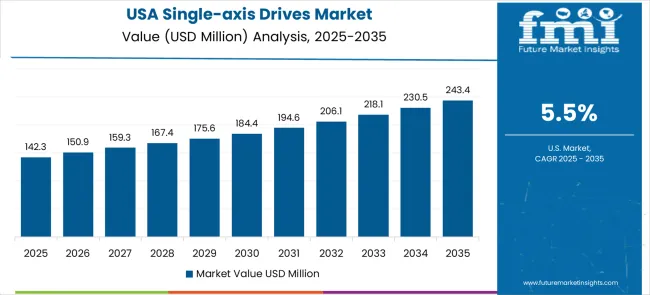
The USA is expanding at a CAGR of 5.5%, driven by established manufacturing companies and growing emphasis on automation enhancement. Large technology corporations and equipment manufacturers are implementing comprehensive motion control capabilities to serve diverse application requirements. The market benefits from established drive supply chains and professional development programs that support various manufacturing applications. Technology industry leadership is enabling standardized drive utilization across multiple equipment types, providing consistent positioning accuracy and comprehensive motion control coverage throughout regional markets. Professional development and certification programs are building specialized technical expertise among engineering professionals, enabling effective motion control technology utilization that supports evolving manufacturing requirements across metropolitan areas. The USA market is characterized by continuous motion control advancement and integration with modern manufacturing and automation systems. Federal research funding programs and technology initiatives are driving development of sophisticated drive systems that meet stringent precision and reliability standards. Manufacturing companies and equipment producers are modernizing their motion control capabilities through adoption of advanced drive technology. The emphasis on manufacturing competitiveness and operational efficiency is supporting demand for high-performance, reliable motion control systems that enhance production capabilities while maintaining positioning accuracy.
The UK is projected to grow at a CAGR of 4.9%, supported by established manufacturing sectors and growing emphasis on automation capabilities. British manufacturing companies and equipment suppliers are implementing drive systems that meet industry precision standards and operational requirements. The market benefits from established manufacturing infrastructure and comprehensive training programs for engineering professionals. Manufacturing investments are prioritizing advanced motion control solutions that support diverse applications while maintaining established precision and operational standards. Professional development programs are building technical expertise among engineering personnel, enabling specialized drive operation capabilities that meet evolving manufacturing requirements and precision standards throughout regional industrial networks. The United Kingdom's comprehensive manufacturing strategy and commitment to maintaining industrial excellence drives continued investment in advanced motion control technology. Manufacturing companies across England, Wales, Scotland, and Northern Ireland are standardizing their motion control solutions to ensure consistent positioning capabilities. Integration with digital manufacturing systems and coordination with automation programs requires sophisticated drive technology. The emphasis on professional engineering training and technology certification is supporting adoption of high-quality motion control systems that meet regulatory standards and operational requirements.
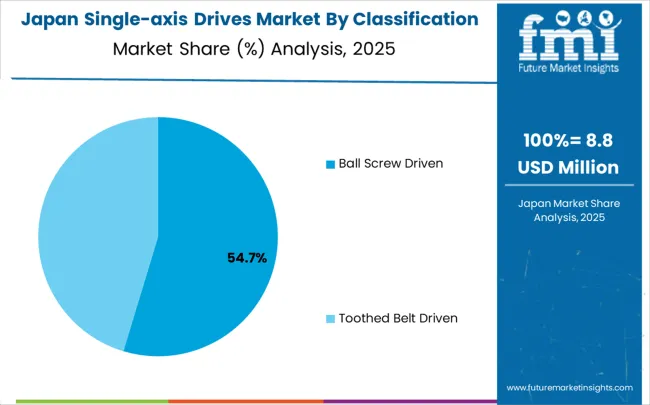
Japan is growing at a CAGR of 4.4%, driven by the country's focus on precision manufacturing and technological excellence applications. Japanese manufacturers are implementing advanced drive systems that demonstrate superior positioning reliability and operational efficiency. The market is characterized by emphasis on technological precision, quality assurance, and integration with established manufacturing workflows. Technology industry investments are prioritizing innovative motion control solutions that combine advanced positioning technology with precision engineering while maintaining Japanese quality and reliability standards. Professional development programs are ensuring comprehensive technical expertise among engineering professionals, enabling specialized motion control capabilities that support diverse manufacturing applications and operational requirements throughout industrial networks. Japan's commitment to maintaining the highest standards of manufacturing precision and technological quality drives continuous advancement in motion control technology. The integration of drive systems with robotic automation and intelligent manufacturing networks requires sophisticated motion control capabilities. Manufacturing companies across Japan's industrial regions are modernizing their positioning systems through procurement of cutting-edge drive technology that meets strict precision and reliability standards. The emphasis on precision engineering and technological advancement is supporting development of next-generation motion control systems with enhanced positioning accuracy and operational capabilities.
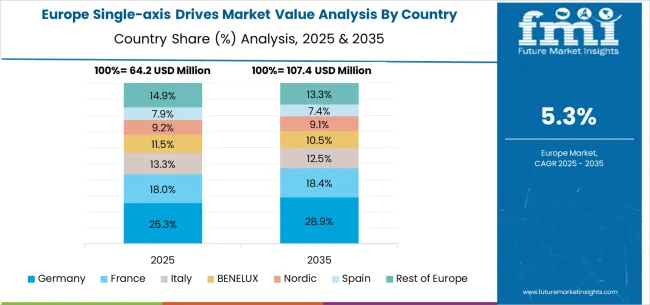
The single-axis drives market in Europe is anticipated to expand from USD 78.1 million in 2025 to approximately USD 137.3 million by 2035, reflecting a CAGR of 5.8% during the forecast period. Germany is set to reinforce its leading position, commanding a 30.4% share of the European market in 2025, supported by its established manufacturing infrastructure, high standards for positioning accuracy, and continuous investment in advanced motion control technologies. The United Kingdom follows with a market share of 18.6%, benefiting from standardized manufacturing procedures, professional development programs, and a robust focus on industrial modernization. France is projected to capture 16.9% of the regional market, fueled by steady integration of modern motion control solutions and enhancements in manufacturing operations. Italy and Spain together represent 18.7% of total demand, as both countries advance their industrial modernization efforts and invest in professional-grade motion control solutions for manufacturing companies. The Rest of Europe, comprising Nordic countries, BENELUX, and Eastern European markets, accounts for 15.4%, driven by regulatory convergence, infrastructure upgrading, and broader adoption of advanced drive technology to support evolving automation requirements and manufacturing optimization programs.
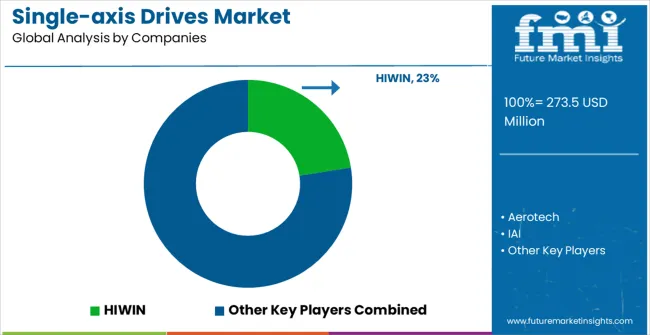
The market is defined by competition among specialized drive manufacturers, automation companies, and motion control solution providers. Companies are investing in advanced drive technology development, positioning accuracy optimization, integration capabilities improvements, and comprehensive application support to deliver reliable, precise, and cost-effective motion control solutions. Strategic partnerships, technological innovation, and market expansion are central to strengthening product portfolios and market presence.
HIWIN offers comprehensive single-axis drive solutions with established manufacturing expertise and professional-grade motion control capabilities. Aerotech provides specialized precision positioning systems with focus on accuracy reliability and operational efficiency. IAI delivers advanced automation solutions with emphasis on integration and application effectiveness. Rockwell Automation specializes in industrial automation systems with comprehensive motion control technologies.
BOSCH Rexroth offers industrial motion solutions with comprehensive automation support capabilities. Festo delivers pneumatic and electric drive systems with advanced motion technologies. Yamaha Motor provides precision positioning equipment with focus on performance optimization. Yaskawa, PI, CKD, NIKKI DENSO, Griffin Motion, KML Linear Motion Technology, and TBI Motion Technology provide specialized manufacturing expertise, drive reliability, and product development across global and regional market segments.
| Item | Value |
|---|---|
| Quantitative Units | USD 273.5 million |
| Drive Type | Ball Screw Driven, Toothed Belt Driven |
| Application | Semiconductors, Chemicals, Medical, Logistics |
| Regions Covered | North America, Europe, East Asia, South Asia & Pacific, Latin America, Middle East & Africa |
| Country Covered | China, India, Germany, Brazil, United States, United Kingdom, Japan, and 40+ countries |
| Key Companies Profiled | HIWIN, Aerotech, IAI, Rockwell Automation, BOSCH Rexroth, Festo, Yamaha Motor, Yaskawa, PI, CKD, NIKKI DENSO, Griffin Motion, KML Linear Motion Technology, TBI Motion Technology |
| Additional Attributes | Dollar sales by drive type and application segment, regional demand trends across major markets, competitive landscape with established drive manufacturers and emerging technology providers, customer preferences for different motion control technologies and positioning options, integration with automation systems and manufacturing equipment, innovations in servo control and intelligent motion technologies, and adoption of modular design features with enhanced precision capabilities for improved manufacturing workflows. |
The global single-axis drives market is estimated to be valued at USD 273.5 million in 2025.
The market size for the single-axis drives market is projected to reach USD 480.7 million by 2035.
The single-axis drives market is expected to grow at a 5.8% CAGR between 2025 and 2035.
The key product types in single-axis drives market are ball screw driven and toothed belt driven.
In terms of application, semiconductors segment to command 38.0% share in the single-axis drives market in 2025.






Our Research Products

The "Full Research Suite" delivers actionable market intel, deep dives on markets or technologies, so clients act faster, cut risk, and unlock growth.

The Leaderboard benchmarks and ranks top vendors, classifying them as Established Leaders, Leading Challengers, or Disruptors & Challengers.

Locates where complements amplify value and substitutes erode it, forecasting net impact by horizon

We deliver granular, decision-grade intel: market sizing, 5-year forecasts, pricing, adoption, usage, revenue, and operational KPIs—plus competitor tracking, regulation, and value chains—across 60 countries broadly.

Spot the shifts before they hit your P&L. We track inflection points, adoption curves, pricing moves, and ecosystem plays to show where demand is heading, why it is changing, and what to do next across high-growth markets and disruptive tech

Real-time reads of user behavior. We track shifting priorities, perceptions of today’s and next-gen services, and provider experience, then pace how fast tech moves from trial to adoption, blending buyer, consumer, and channel inputs with social signals (#WhySwitch, #UX).

Partner with our analyst team to build a custom report designed around your business priorities. From analysing market trends to assessing competitors or crafting bespoke datasets, we tailor insights to your needs.
Supplier Intelligence
Discovery & Profiling
Capacity & Footprint
Performance & Risk
Compliance & Governance
Commercial Readiness
Who Supplies Whom
Scorecards & Shortlists
Playbooks & Docs
Category Intelligence
Definition & Scope
Demand & Use Cases
Cost Drivers
Market Structure
Supply Chain Map
Trade & Policy
Operating Norms
Deliverables
Buyer Intelligence
Account Basics
Spend & Scope
Procurement Model
Vendor Requirements
Terms & Policies
Entry Strategy
Pain Points & Triggers
Outputs
Pricing Analysis
Benchmarks
Trends
Should-Cost
Indexation
Landed Cost
Commercial Terms
Deliverables
Brand Analysis
Positioning & Value Prop
Share & Presence
Customer Evidence
Go-to-Market
Digital & Reputation
Compliance & Trust
KPIs & Gaps
Outputs
Full Research Suite comprises of:
Market outlook & trends analysis
Interviews & case studies
Strategic recommendations
Vendor profiles & capabilities analysis
5-year forecasts
8 regions and 60+ country-level data splits
Market segment data splits
12 months of continuous data updates
DELIVERED AS:
PDF EXCEL ONLINE
AC Drives Market Size and Share Forecast Outlook 2025 to 2035
Mini Drives Market Analysis Size and Share Forecast Outlook 2025 to 2035
Servo Drives Market Size and Share Forecast Outlook 2025 to 2035
Gears, Drives and Speed Changers Market Growth – Trends & Forecast 2025 to 2035
Conveyor Drives Market Analysis - Size, Share, and Forecast Outlook 2025 to 2035
Ship Pod Drives Market Size and Share Forecast Outlook 2025 to 2035
Brushless Drives Market Analysis Size and Share Forecast Outlook 2025 to 2035
Automotive Driveshaft Couplings Market
Low Voltage Drives Market Size and Share Forecast Outlook 2025 to 2035
Medium Voltage Drives Market Analysis - Size, Share, and Forecast Outlook 2025 to 2035
Industrial Chain Drives Market Size, Growth, and Forecast 2025 to 2035
Automotive Sunroof Drives Market Size and Share Forecast Outlook 2025 to 2035
DC Servo Motors and Drives Market Size and Share Forecast Outlook 2025 to 2035
Digital Servo Motors and Drives Market Size and Share Forecast Outlook 2025 to 2035
Marine Variable Frequency Drives Market Size and Share Forecast Outlook 2025 to 2035
Large Scale Medium Voltage Drives Market Size and Share Forecast Outlook 2025 to 2035
Electric & Hydraulic Wellhead Drives for Onshore Application Market Insights - Demand, Size & Industry Trends 2025 to 2035
Large Scale Variable Frequency Drives Market Size and Share Forecast Outlook 2025 to 2035
North America Variable Frequency Drives Market Growth – Trends & Forecast 2024-2034

Thank you!
You will receive an email from our Business Development Manager. Please be sure to check your SPAM/JUNK folder too.
Chat With
MaRIA